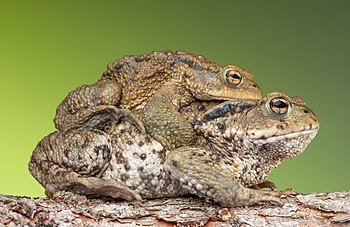Talk:Amplexus
| This article is rated B-class on Wikipedia's content assessment scale. It is of interest to the following WikiProjects: | |||||||||||
| |||||||||||
Wiki Education Foundation-supported course assignment[edit]
![]() This article was the subject of a Wiki Education Foundation-supported course assignment, between 4 September 2019 and 27 November 2019. Further details are available on the course page. Student editor(s): Emw3181. Peer reviewers: K.white31, Emilygeorge06, Hmc442, Ethologyisfun31.
This article was the subject of a Wiki Education Foundation-supported course assignment, between 4 September 2019 and 27 November 2019. Further details are available on the course page. Student editor(s): Emw3181. Peer reviewers: K.white31, Emilygeorge06, Hmc442, Ethologyisfun31.
Above undated message substituted from Template:Dashboard.wikiedu.org assignment by PrimeBOT (talk) 14:06, 16 January 2022 (UTC)
Limited to frogs?[edit]
Do other animals perform amplexus? The article makes it seem unique to frogs. —Keenan Pepper 01:47, 27 March 2006 (UTC)
- I've seen references in books on adaptive behavior and morphology that indicate that amplexus is not confined to the act of fertilization; it is apparently also used by males in some species to guard a chosen female until she gets around to laying her eggs. There are millipedes who exhibit the same behavior, but I don't know if it's called amplexus when they do it. Sacredwombat 01:19, 29 April 2006 (UTC)
- I doubt that is amplexus. It would have to be the same process as in the frogs, and the frogs obviously don't do the male-male thing, as the eggs are laid while in amplexus with the female. Also, if a male grips a male, the male that is gripped will scream, and make the male get off. --liquidGhoul 00:58, 20 August 2006 (UTC)
File:Amplexus Bufo bufo 2010-03-29.jpg to appear as POTD[edit]
Hello! This is a note to let the editors of this article know that File:Amplexus Bufo bufo 2010-03-29.jpg will be appearing as picture of the day on June 27, 2013. You can view and edit the POTD blurb at Template:POTD/2013-06-27. If this article needs any attention or maintenance, it would be preferable if that could be done before its appearance on the Main Page. Thanks! — Crisco 1492 (talk) 00:50, 11 June 2013 (UTC)
> "he fertilizes the female eggs"[edit]
In humans, eggs *all* carry X chromosomes, and thus are in a manner of speaking "female." Is this different in frogs, necessitating the specification? If so, how does he avoid fertilizing the male eggs?
2warped@gmail.com 71.238.46.250 (talk) 19:52, 27 August 2014 (UTC)
More Wikipedia rubbish.[edit]
I learn here that amplexus is "a form of pseudocopulation". Thats it. Clicking on the link to 'pseudocopulation' I learn that it is chiefly done by plants. Oh, real helpful. Still don't have the faintest idea what the definition of the term is, but at least now I know that the frogs 'doing it' must be vegatative matter. Incidentially, "sexual union" is no more helpful. Anyone with a lick of sense knows you don't define one technical term with another, if your intent is clarity. As a hint (and I really don't have any idea what the definitions are for pseudocopulation or amplexus; or even what generically defines copulation) the terms that SHOULD be included are "internal/external" fertilization, penis or phallus (etc.). Describing it as including fertilization with a sperm containing liquid does not serve to distinguish it from the most familiar types of sexual reproductive acts, does it?173.189.74.254 (talk) 20:10, 27 August 2014 (UTC)
- I've removed the unnecessary link to pseudocopulation and rewritten the introduction for clarity: external fertilization is explicitly mentioned and the physical nature of amplexus mentioned in contrast to broadcast spawning. Although the article still has much to be expanded upon (still only a Start class) please let me know if it is easier to understand as such. Cheers! --Animalparty-- (talk) 04:35, 28 August 2014 (UTC)

